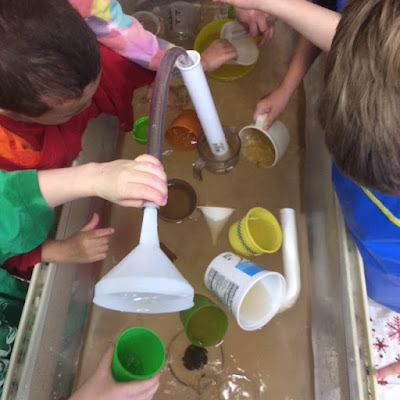Since my last post I have been thinking more about play. Why
is it so hard to understand its importance? Then, two days ago, I went to visit
a friend who has made (“French”) horns all of his adult life. George wasn’t
trained as an engineer. He had drafting lessons in the Navy, and went on to be
chief engineer for a well-known brass instrument company. Finally, he set out
on his own to build horns by hand. His horns are played in symphonies all over
the world. He has so many patents he has lost count. George is 84 years old. He
still talks about horn making like a child with a new toy. He said something that
struck me as the essence of playful creativity during our lunch together: “People
say I should just order mouthpieces from Europe. It would be so much easier and
quicker. Why do I make my mouthpieces by hand? And I tell them, well, what fun
would THAT be?!”
What fun indeed?
This morning, my Pre-K students were all over the room solving problems through play. When I say play, I mean not only playing with materials, or playing games, or playing pretend scenarios, but playing with ideas as well. Two boys worked together with Magna-tiles to make something that they envisioned: A rocket within a space station. They worked for a long time to get the surrounding “station” just right so that the separate rocket would fit inside, but slide out easily for launching. Two girls challenged themselves to make a ball go “up” a ramp. Through trial and error, they made two ramps connect so that when a ball ran down the first ramp, it would, through momentum, go up the second one, only to slide down again. Their image was that of a skateboarder going up a ramp and coming back down, they said.
Is this only play?
If someone walked into our classroom they would see children playing with many
materials, including Magna-tiles, and ramps with balls. They would not see the
creative problem-solving, nor the give and take of conversation driving the
creative thought. They might think, “Oh, well, I want my child to learn. This is just playing.” How wrong they would be!
Einstein said that playing with images and thoughts was
crucial before actually thinking and speaking logically about a new idea. When
children play with toys, art materials, or socio-dramatic roles, they are
thinking, and playing with images in their minds. If we allow and even facilitate
this kind of thinking in play, we may just be nurturing an Einstein, or another
George. Can we afford to lose this opportunity? I sincerely think not.
To learn more about learning through play you might want to
read about observing children at play to see their thinking and learning.
School ultimately must prepare children for the future, so we must help them
learn to learn, and think about their thinking. Discovery is intrinsically
rewarding, as Jerome Bruner wrote. Using one’s own faculties to discover new ways to do things makes
learning “fun”. It is what both children and grown-ups actually want, after
all.









